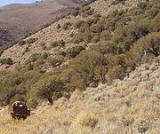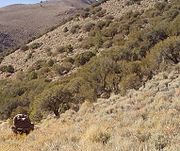
Carson-Iceberg Wilderness
Encyclopedia
The Carson-Iceberg Wilderness is a federal wilderness area located 80 miles (128.7 km) northeast of Stockton, California
. It encompasses 160000 acres (647.5 km²) and was designated by the California Wilderness Act of 1984
. It protects an area of High Sierra landscape with elevations from 4800 feet (1,463 m) to 11462 feet (3,493.6 m) along the Sierra Mountains from Ebbetts Pass to Sonora Pass in the south. The US Forest Service manages the wilderness which is in both the Stanislaus National Forest
and the Humboldt-Toiyabe National Forest
.
Located in the wilderness are the headwaters of the Carson River
draining the east side of the crest, as well as the North and Middle Forks of the Stanislaus River
on the west slopes.
The name Carson-Iceberg comes from two prominent geographical features: the Carson River (named for noted scout and explorer Kit Carson
) and the distinctive granite formation called "The Iceberg" on the southern boundary near Clark Fork Road.
Historical highlights: Jedediah Smith
crossed the Sierra Nevada Range near Ebbetts Pass sometime in 1827, and the first immigrant party of Bartleson-Bidwell
crossed over in 1841 near Sonora Pass.
The wilderness supports large herds of mule deer
and there is also good habitat for black bear
, which have become a problem due to an insatiable appetite for backpackers' food.
The forest cover consists of lodgepole pine
, Jeffrey pine
, aspen, Sierra juniper and curl-leaf mountain mahogany
.

in existence in the drainages of Silver King Creek, a tributary of the East Fork Carson River. They were listed as endangered under the Endangered Species Preservation Act of 1966 and upgraded to threatened status in 1973 with the passage of the Endangered Species Act
(ESA) which allowed regulated fishing of the Paiute. Historically, the US Fish and Wildlife Service believe the Paiute trout only occupied the Silver King Creek and its tributaries below the barrier of LLewellyn Falls, and around 1912 were introduced to other streams where the Paiute hybridized with the Lahonton and rainbow trout species.
The revised recovery plan by the US Fish and Wildlife Service seeks to remove nonnative fish from the environment, protect habitat for the current populations of Paiute trout, both within the historical range of the Silver King Creek watershed and the other streams in the region, such as North Fork Cottonwood Creek, and lastly, to study the Paiute trout to better understand the population trends.
The main distinguishing characteristic is the lack of spots on the body. The closely related Lahontan cutthroat trout
has between 50 to 100 spots whereas the Paiute may have five or none.
The Paiute trout require a habitat of clean, well-oxygenated, moving water with gravel bottoms and quiet pools near riparian zones. They reach maturity in 2 years, spawn during June and July with eggs hatching in 6–8 weeks and the fry emerging from the gravel in 2–3 weeks. The rate of growth depends on water temperature and food access, with the Silver King Creek Paiute having been measured at 13.5 inches. Predators include the water shrew and the dipper, a bird that can go underwater to feed. Humans impact the Paiute trout as the fish show a lack of wariness to anglers, possibly because of the high elevation environment and lack of predators. Serious population declines have occurred from moderate to light fishing of the trout.
Also in the Silver King Creek watershed are the mountain yellow-legged frog and the Yosemite toad.
Leave No Trace
methods of wilderness travel are highly encouraged by the US Forest Service.
Stockton, California
Stockton, California, the seat of San Joaquin County, is the fourth-largest city in the Central Valley of the U.S. state of California. With a population of 291,707 at the 2010 census, Stockton ranks as this state's 13th largest city...
. It encompasses 160000 acres (647.5 km²) and was designated by the California Wilderness Act of 1984
California Wilderness Act of 1984
The California Wilderness Act of 1984 is a federal law , passed by the United States Congress on September 28, 1984, that authorized the addition of over within the state of California to the National Wilderness Preservation System....
. It protects an area of High Sierra landscape with elevations from 4800 feet (1,463 m) to 11462 feet (3,493.6 m) along the Sierra Mountains from Ebbetts Pass to Sonora Pass in the south. The US Forest Service manages the wilderness which is in both the Stanislaus National Forest
Stanislaus National Forest
Stanislaus National Forest contains in four counties in the Sierra Nevada Mountains of Northern California. It was established on February 22, 1897, making it one of the oldest national forests...
and the Humboldt-Toiyabe National Forest
Humboldt-Toiyabe National Forest
The Humboldt-Toiyabe National Forest is the principal U.S. National Forest located in the U.S. state of Nevada. With an area of , it is the largest National Forest of the United States outside of Alaska...
.
Located in the wilderness are the headwaters of the Carson River
Carson River
The Carson River is a northwestern Nevada river that empties into the Carson Sink, an endorheic basin. The main stem of the river is long....
draining the east side of the crest, as well as the North and Middle Forks of the Stanislaus River
Stanislaus River
The Stanislaus River in California is one of the largest tributaries of the San Joaquin River. The river is long and has north, middle and south forks...
on the west slopes.
The name Carson-Iceberg comes from two prominent geographical features: the Carson River (named for noted scout and explorer Kit Carson
Kit Carson
Christopher Houston "Kit" Carson was an American frontiersman and Indian fighter. Carson left home in rural present-day Missouri at age 16 and became a Mountain man and trapper in the West. Carson explored the west to California, and north through the Rocky Mountains. He lived among and married...
) and the distinctive granite formation called "The Iceberg" on the southern boundary near Clark Fork Road.
Historical highlights: Jedediah Smith
Jedediah Smith
Jedediah Strong Smith was a hunter, trapper, fur trader, trailblazer, author, cartographer, cattleman, and explorer of the Rocky Mountains, the American West Coast and the Southwest during the 19th century...
crossed the Sierra Nevada Range near Ebbetts Pass sometime in 1827, and the first immigrant party of Bartleson-Bidwell
Bartleson-Bidwell Party
In 1841, the Bartleson–Bidwell Party led by Captain John Bartleson and John Bidwell, became the first American emigrants to attempt a wagon crossing from Missouri to California.-The trail:...
crossed over in 1841 near Sonora Pass.
The wilderness supports large herds of mule deer
Mule Deer
The mule deer is a deer indigenous to western North America. The Mule Deer gets its name from its large mule-like ears. There are believed to be several subspecies, including the black-tailed deer...
and there is also good habitat for black bear
American black bear
The American black bear is a medium-sized bear native to North America. It is the continent's smallest and most common bear species. Black bears are omnivores, with their diets varying greatly depending on season and location. They typically live in largely forested areas, but do leave forests in...
, which have become a problem due to an insatiable appetite for backpackers' food.
The forest cover consists of lodgepole pine
Lodgepole Pine
Lodgepole Pine, Pinus contorta, also known as Shore Pine, is a common tree in western North America. Like all pines, it is evergreen.-Subspecies:...
, Jeffrey pine
Jeffrey Pine
The Jeffrey Pine, Pinus jeffreyi, named in honor of its botanist documenter John Jeffrey, is a North American pine related to Ponderosa Pine.-Distribution and habitat:...
, aspen, Sierra juniper and curl-leaf mountain mahogany
Cercocarpus ledifolius
Cercocarpus ledifolius is a species of mountain mahogany known by the common name curl-leaf mountain mahogany.-Description:This is a large, densely-branching shrub or a tree which may reach 10 meters in height. Its leathery, sticky, dark green leaves are up to 4 centimeters long and lance-shaped,...
.

Paiute cutthroat trout
The Carson-Iceberg Wilderness supports a native population of the only Paiute cutthroat troutPaiute cutthroat trout
Paiute cutthroat trout is a subspecies of cutthroat trout native only to Silver King Creek, a headwater tributary of the Carson River in the Sierra Nevada Mountains of California, U.S.A. The Carson River lies within the Great Basin interior drainage system, within the historic range of Lahontan...
in existence in the drainages of Silver King Creek, a tributary of the East Fork Carson River. They were listed as endangered under the Endangered Species Preservation Act of 1966 and upgraded to threatened status in 1973 with the passage of the Endangered Species Act
Endangered Species Act
The Endangered Species Act of 1973 is one of the dozens of United States environmental laws passed in the 1970s. Signed into law by President Richard Nixon on December 28, 1973, it was designed to protect critically imperiled species from extinction as a "consequence of economic growth and...
(ESA) which allowed regulated fishing of the Paiute. Historically, the US Fish and Wildlife Service believe the Paiute trout only occupied the Silver King Creek and its tributaries below the barrier of LLewellyn Falls, and around 1912 were introduced to other streams where the Paiute hybridized with the Lahonton and rainbow trout species.
The revised recovery plan by the US Fish and Wildlife Service seeks to remove nonnative fish from the environment, protect habitat for the current populations of Paiute trout, both within the historical range of the Silver King Creek watershed and the other streams in the region, such as North Fork Cottonwood Creek, and lastly, to study the Paiute trout to better understand the population trends.
The main distinguishing characteristic is the lack of spots on the body. The closely related Lahontan cutthroat trout
Lahontan cutthroat trout
Lahontan cutthroat trout is the largest subspecies of cutthroat trout, and the state fish of Nevada.-Natural history:...
has between 50 to 100 spots whereas the Paiute may have five or none.
The Paiute trout require a habitat of clean, well-oxygenated, moving water with gravel bottoms and quiet pools near riparian zones. They reach maturity in 2 years, spawn during June and July with eggs hatching in 6–8 weeks and the fry emerging from the gravel in 2–3 weeks. The rate of growth depends on water temperature and food access, with the Silver King Creek Paiute having been measured at 13.5 inches. Predators include the water shrew and the dipper, a bird that can go underwater to feed. Humans impact the Paiute trout as the fish show a lack of wariness to anglers, possibly because of the high elevation environment and lack of predators. Serious population declines have occurred from moderate to light fishing of the trout.
Also in the Silver King Creek watershed are the mountain yellow-legged frog and the Yosemite toad.
Permits
A permit is required from May to October for overnight visits into the wilderness but can be used to visit more than one wilderness area in a single trip. There is a limit of 15 people and 25 stock in the wilderness.Leave No Trace
Leave No Trace
Leave No Trace is both a set of principles, and an organization that promotes those principles. The principles are designed to assist outdoor enthusiasts with their decisions about how to reduce their impacts when they hike, camp, picnic, snowshoe, run, bike, hunt, paddle, ride horses, fish, ski or...
methods of wilderness travel are highly encouraged by the US Forest Service.

